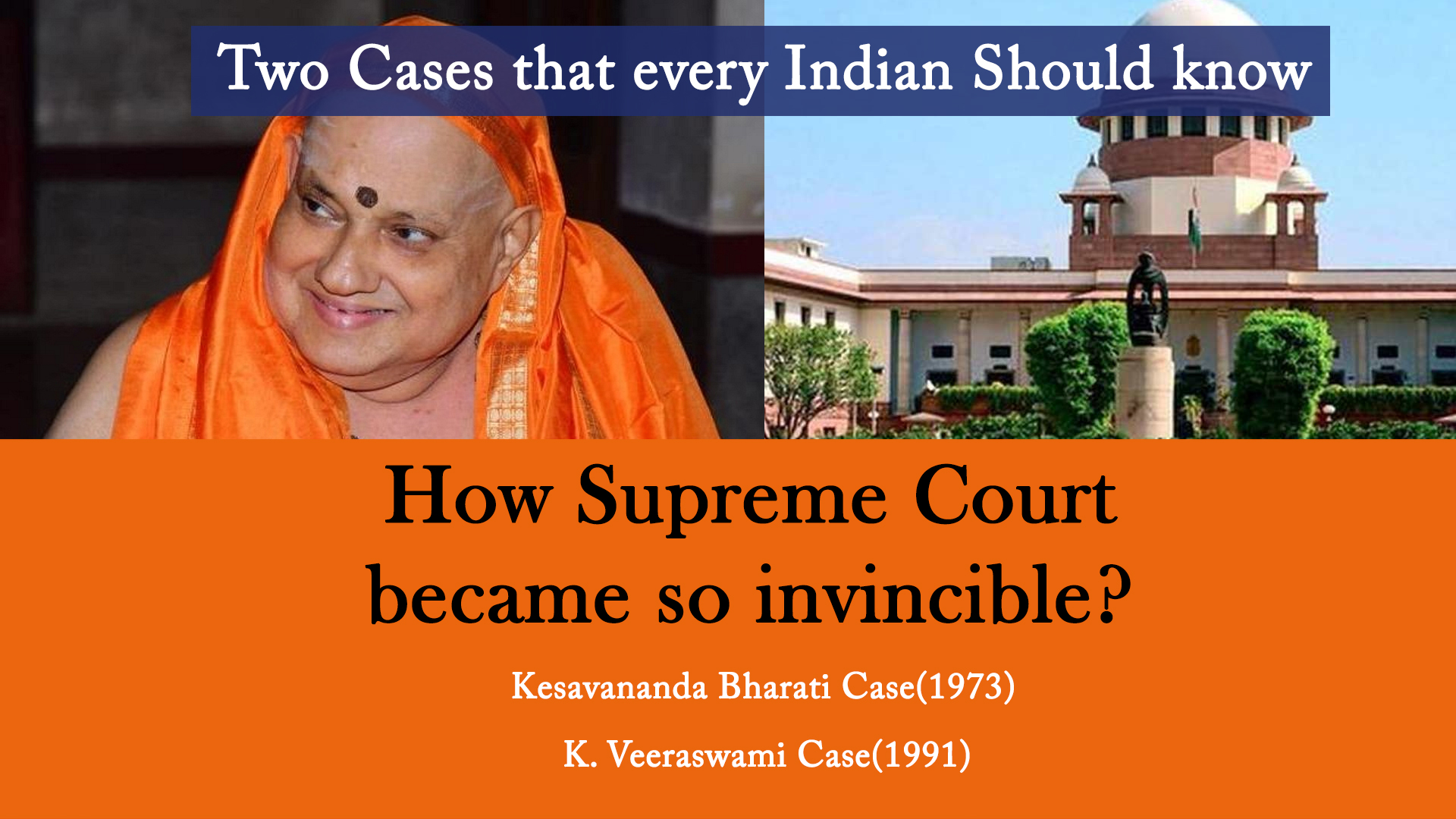Imagine a court so powerful that it can block laws made by your elected leaders, delay justice for decades in cases that matter to millions, and protect its judges even when piles of burnt cash are found in their homes. This is the Supreme Court of India today, and it all traces back to a single case in 1973 called Kesavananda Bharati v. State of Kerala. This case gave the Supreme Court unchecked power, took away Parliament’s rights, and made judges untouchable, often at the cost of justice for the common man. From delaying the Ram Mandir case for decades to fast-tracking Waqf hearings, the Supreme Court’s actions raise questions about its fairness. Let’s break it down in simple terms to understand how this happened and why it matters to every Indian.
The Kesavananda Bharati Case: A Power Grab in 1973
Back in 1973, a religious leader from Kerala, Kesavananda Bharati, challenged a state law that limited his group’s land rights. The case reached the Supreme Court, but it wasn’t just about land—it became a massive fight over who controls India’s Constitution. At the time, Parliament, elected by the people, could change the Constitution through amendments. But the Supreme Court wanted to limit this power.
A huge bench of 13 judges heard the case, and by a close 7-6 vote, they created something called the Basic Structure Doctrine. This rule says that Parliament can amend the Constitution, but it cannot touch certain “basic” parts, like the Supreme Court’s independence, its power to review laws, or fundamental rights. The judges decided that they, not Parliament, would decide what these “basic” parts are.
What Did This Do?
- Stripped Parliament’s Power: Before 1973, Parliament, representing the people, could freely amend the Constitution. After Kesavananda Bharati, the Supreme Court became the boss, able to strike down any amendment it didn’t like by saying it harmed the “basic structure.”
- Made the Supreme Court Untouchable: The judges declared their own independence as part of this “basic structure,” meaning no one could challenge their authority or easily hold them accountable.
- Gave Judges Final Say: The Supreme Court became the ultimate referee, deciding what’s constitutional and what’s not, even overruling laws made by elected leaders.
This was a game-changer. The Supreme Court went from being a court to a super-powerful institution that could block the will of the people’s representatives. And it all started with Kesavananda Bharati.
The K. Veeraswami Case: Protecting Judges from Accountability
If you think the Supreme Court’s power grab stopped at blocking Parliament, think again. In 1991, another case, K. Veeraswami v. Union of India, made it even harder to hold judges accountable for crimes. K. Veeraswami, a former Chief Justice of the Madras High Court, was accused of corruption. The question was: Can a judge be investigated or arrested like a regular person?
The Supreme Court ruled that judges can be prosecuted for crimes like taking bribes, but there’s a catch—you need the Chief Justice of India’s permission to even file an FIR (police complaint) against a judge. If the Chief Justice says no, the case is dead. This rule was meant to protect judges from fake complaints, but it’s become a shield for those who might be guilty.
Why This Matters
- Judges Above the Law?: The Veeraswami case means a judge can’t be easily investigated, even if there’s evidence of wrongdoing. The Chief Justice, another judge, decides whether the case moves forward, creating a system where judges protect their own.
- Burnt Cash in a Judge’s House: Recently, a shocking incident came to light. A High Court judge’s house caught fire, and piles of burnt cash was recovered. This raises serious questions: Was it corrupt money? Why was it burnt? Yet, because of the Veeraswami rule, investigating this judge would need the Chief Justice’s approval, which often delays or blocks justice. The common man wonders—why are judges so protected when ordinary people face instant police action for far less?
- No Transparency: The Veeraswami decision makes it nearly impossible for the public to know if a judge is being investigated, leaving people distrustful of the system.
The Kesavananda Bharati case gave the Supreme Court its power, and the Veeraswami case made sure its judges could hide behind that power, even when suspicions of corruption arise.
The Supreme Court’s Bias: Delays for Hindus, Speed for Waqf
The Supreme Court’s unchecked power and lack of accountability have led to a perception of bias, especially in cases that matter to millions of Indians. The Kesavananda Bharati case made the Supreme Court the final word, but it’s using that word to delay justice for some while rushing it for others.
The Ram Mandir Case: Decades of Delay
The Ram Mandir dispute in Ayodhya, one of the most important cases for Hindus, dragged on for decades in the Supreme Court. This wasn’t just a legal issue—it was about faith, history, and justice for millions. Yet, the Supreme Court kept postponing hearings, letting the case linger for years, even centuries if you count the historical struggle. The final verdict came in 2019, but only after endless delays that frustrated Hindus across India. Other Hindu-related cases, like those involving temple rights or festivals, often face similar slow treatment, taking years to resolve.
Waqf Cases: Urgent Hearings
Contrast this with Waqf cases, which involve Muslim religious properties. The Supreme Court often gives these cases urgent hearing dates, pushing them to the front of the line. For example, disputes over Waqf board claims or properties get quick attention, while Hindu cases wait in the shadows. This difference in treatment fuels anger among common people, who see the Supreme Court as favoring certain groups—leftists and Muslims—over others.
Why the Bias?
The Supreme Court’s power, cemented by Kesavananda Bharati, lets it decide which cases to prioritize without anyone questioning it. Its judges, protected by the Veeraswami rule, face no pressure to explain delays or apparent biases. The result? A court that seems to work faster for some communities while making others wait decades for justice.
Corruption Concerns: The Burnt Cash Scandal
On March 14, 2025, a fire at Delhi High Court judge Justice Yashwant Varma’s bungalow in New Delhi revealed sacks of burnt cash, reportedly worth crores. The fire brigade found the money while putting out the blaze, sparking outrage: Was it bribe money? Why was it burnt? The K. Veeraswami case (1991) blocks police from filing an FIR without the Chief Justice’s approval, and the Kesavananda Bharati case (1973) protects judges by making the judiciary untouchable. For the common man, struggling to survive, it’s infuriating that judges, meant to uphold justice, escape scrutiny when linked to such scandals.
How Kesavananda Bharati Changed Everything
Before the Kesavananda Bharati case, Parliament, elected by you and me, had the power to shape India’s laws and Constitution. If the people didn’t like a law, they could vote for new leaders to change it. But after 1973, the Supreme Court took that power away. It said, “We decide what’s right, not Parliament.” This shift gave judges more control than elected representatives, turning the Supreme Court into a super-authority.
- No Checks on Power: The Basic Structure Doctrine means the Supreme Court can block any law or amendment it doesn’t like, claiming it harms the Constitution’s “basic” parts. But who decides what’s basic? The judges do, and no one can challenge them.
- Judges Protect Themselves: The Kesavananda Bharati case made judicial independence sacred, which sounds good but means judges can’t be easily questioned or removed. Even when cash burns in their homes, the system shields them.
- Delays and Bias: With so much power, the Supreme Court picks and chooses cases to favor. Hindu cases like Ram Mandir wait forever, while Waqf cases get quick hearings, leaving people feeling the court leans toward leftists and Muslims.
The Kesavananda Bharati case didn’t just limit Parliament—it handed the Supreme Court a blank check to control India’s laws, delays, and even its judges’ accountability.
Why This Matters to You
As a common Indian, you expect justice to be fair and fast. But the Supreme Court, empowered by Kesavananda Bharati and shielded by Veeraswami, often fails to deliver. If you’re a Hindu waiting for a temple case to be heard, you might wait decades. If you hear about burnt cash in a judge’s house, you’ll wonder why no one can investigate. The Supreme Court’s power, once meant to protect the Constitution, now feels like a wall between the people and justice.
The Kesavananda Bharati case took power from your elected leaders and gave it to unelected judges. The Veeraswami case made sure those judges stay above the law. Together, they’ve created a Supreme Court that can delay justice, show bias, and protect its own, leaving the common man frustrated and unheard.





